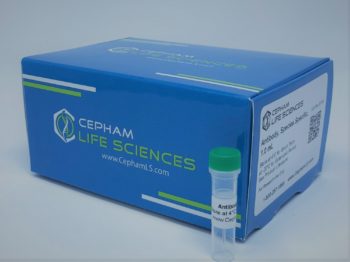Description
Aliases
Calgranulin-A, Chemotactic cytokine CP-10, Leukocyte L1 complex light chain, Migration inhibitory factor-related protein 8, Pro-inflammatory S100 cytokine, S100 calcium-binding protein A8, Caga, Mrp8, S100a8
Antibody Type
Polyclonal Antibody
Species
Mouse
Uniprot ID
P27005
Immunogen
Recombinant mouse Protein S100-A8 protein (1-93AA)
Raised In
Rabbit
Species Reactivity
Mouse
Tested Applications
ELISA;Not yet tested in other applications.
Background / Function
S100A8 is a calcium- and zinc-binding protein which plays a prominent role in the regulation of inflammatory processes and immune response. It can induce neutrophil chemotaxis and adhesion. Predominantly found as calprotectin (S100A8/A9) which has a wide plethora of intra- and extracellular functions. The intracellular functions include: facilitating leukocyte arachidonic acid trafficking and metabolism, modulation of the tubulin-dependent cytoskeleton during migration of phagocytes and activation of the neutrophilic NADPH-oxidase. Activates NADPH-oxidase by facilitating the enzyme complex assembly at the cell membrane, transferring arachidonic acid, an essential cofactor, to the enzyme complex and S100A8 contributes to the enzyme assembly by directly binding to NCF2/P67PHOX. The extracellular functions involve proinfammatory, antimicrobial, oxidant-scavenging and apoptosis-inducing activities. Its proinflammatory activity includes recruitment of leukocytes, promotion of cytokine and chemokine production, and regulation of leukocyte adhesion and migration. Acts as an alarmin or a danger associated molecular pattern (DAMP) molecule and stimulates innate immune cells via binding to pattern recognition receptors such as Toll-like receptor 4 (TLR4) and receptor for advanced glycation endproducts (AGER). Binding to TLR4 and AGER activates the MAP-kinase and NF-kappa-B signaling pathways resulting in the amplification of the proinflammatory cascade. Has antimicrobial activity towards bacteria and fungi and exerts its antimicrobial activity probably via chelation of Zn2+ which is essential for microbial growth. Can induce cell death via autophagy and apoptosis and this occurs through the cross-talk of mitochondria and lysosomes via reactive oxygen species (ROS) and the process involves BNIP3. Can regulate neutrophil number and apoptosis by an anti-apoptotic effect; regulates cell survival via ITGAM/ITGB and TLR4 and a signaling mechanism involving MEK-ERK. Its role as an oxidant scavenger has a protective role in preventing exaggerated tissue damage by scavenging oxidants.
Isotype
IgG
Conjugate
Biotin
Storage Buffer
Preservative: 0.03% Proclin 300
Constituents: 50% Glycerol, 0.01M PBS, PH 7.4
Form
Liquid
Storage
Shipped at 4°C. Upon delivery aliquot and store at -20°C or -80°C. Avoid repeated freeze.
Purity
Caprylic Acid Ammonium Sulfate Precipitation purified
Modification
Protein S100-A8
Literature
[1]”Inflammation-associated S100 proteins: new mechanisms that regulate function.” Goyette J., Geczy C.L. Amino Acids 41:821-842(2011). [2]”Anti-infective protective properties of S100 calgranulins.” Hsu K., Champaiboon C., Guenther B.D., Sorenson B.S., Khammanivong A., Ross K.F., Geczy C.L., Herzberg M.C. Antiinflamm. Antiallergy Agents Med. Chem. 8:290-305(2009). [3]”S100A8 and S100A9 mediate endotoxin-induced cardiomyocyte dysfunction via the receptor for advanced glycation end products.” Boyd J.H., Kan B., Roberts H., Wang Y., Walley K.R. Circ. Res. 102:1239-1246(2008).Additional information
| Size | 50μg, 100μg |
|---|


